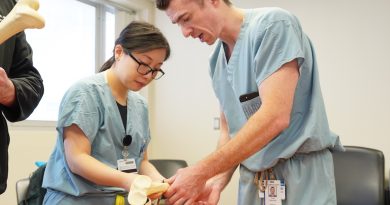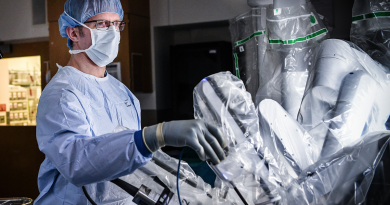What is this bulge? Can I still exercise?
Experiencing new bulging, sudden pain or discomfort in your abdomen or groin area can be alarming. One possible cause of such discomfort is a hernia. A hernia occurs when an organ or fatty tissue pushes through a weak spot in the surrounding muscle or connective tissue.
 Hernias can manifest in various shapes and locations, including the groin (inguinal or femoral hernia), belly button (umbilical hernia) or other locations across the belly, possibly at old surgery sites (ventral and incisional hernias). Regardless of the type, hernias can cause discomfort, pain and in severe cases, potential complications that may require immediate medical attention.
Hernias can manifest in various shapes and locations, including the groin (inguinal or femoral hernia), belly button (umbilical hernia) or other locations across the belly, possibly at old surgery sites (ventral and incisional hernias). Regardless of the type, hernias can cause discomfort, pain and in severe cases, potential complications that may require immediate medical attention.
Symptoms
- Visible bulge or swelling: You might notice a lump or protrusion in the affected area, which becomes more apparent when standing or straining.
- Discomfort or pain: Hernias can cause discomfort, ranging from a dull ache to sharp pain. Some individuals may experience a sense of pressure or sensation of heaviness or pulling around the site of the hernia, particularly after prolonged standing, strenuous activity or heavy lifting.
When to See Your Doctor
If you suspect you have a hernia, consult a healthcare professional for an accurate diagnosis. They will examine the affected area, review your symptoms and potentially order additional tests such as an ultrasound or CT scan to confirm the presence of a hernia.
Treatment Options
The management of a hernia depends on various factors such as the size, type and severity of the condition.
“At the Baylor Medicine Hernia Center, we will discuss both surgical and non-operative management with you,” says Heather West, patient navigator. “Sometimes patients may not be candidates for surgery or may need to lose weight or make other changes to be the optimum health prior to surgery. Part of the visit is to not only determine the severity of the hernia, but to educate the patient on what they can and can’t do safely.”
Lifestyle Modifications
Making certain changes to your daily routine can help alleviate hernia symptoms and prevent further complications. Potential recommendations may include avoiding constipation, maintaining a healthy weight or physical therapy.
Wearing an abdominal binder or thick elastic support brace can provide abdominal support that may reduce discomfort during physical activity, says West.
Physical Activity
There is no set list of exercises or activities that are specific to those with hernias. If the hernia is interfering with exercise, then we consult with a doctor about fixing it! It is better for your overall health to be physically active than limited because of the hernia.
“Just because you have a hernia does not mean you cannot exercise,” says West. “In fact, it is a common misconception that every person with a hernia needs to avoid heavy lifting. As long as it is not causing increased pain, we encourage patients to continue to participate in their regular activities, including exercise and heavy lifting.”
In addition, patients are often recommended to lose weight prior to hernia repair surgery, and exercise is a key factor in weight loss success.
A strong core is really beneficial in the setting of a hernia. If you are dealing with diastasis recti, core strengthening can help decrease the distance between the muscles and therefore decrease the prominence of the belly bulge.
Strengthening your core may also help reduce the risk of hernia recurrence, or the hernia coming back after a surgery repair. A course of physical therapy targeted on core strengthening may be of benefit before and even after hernia repair.
“If you feel that core weakness, or the presence of the bulge is limiting your participation in activity, you can try wearing an abdominal binder to provide some additional support,” suggests West. “This binder will not change the presence of the hernia but may allow you to overcome some of that core weakness so that you can continue to exercise and be active.”
It is recommended that you have your belly bulge or hernia evaluated before proceeding with exercise. By staying informed and proactive, you can take control of your hernia and work towards a healthier, pain-free future.
Learn more about hernias at the Baylor Medicine Hernia Center.
By Tiffany Harston, communications associate with the Michael E. DeBakey Department of Surgery



